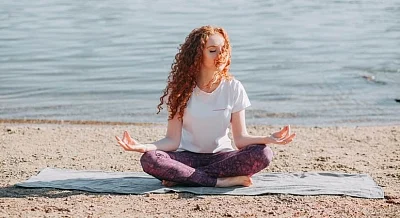Anxiety is a result of stress and is part of the natural fight, flight, or freeze reflex. Anxiety may feel like distress, unease, or dread. Its main aim is to keep a person alert or aware during times of threat.
Sometimes, anxiety can get worse and get in the way of everyday life. This can be experienced more often by people who live with health conditions that result in excessive anxiety, like OCD or GAD. According to the doctors of Mayo Clinic, exercise and yoga can help people manage the symptoms of anxiety.
In this article, let's look at a few easy yoga poses that can help manage anxiety.
1. Extended Triangle Pose
This is a classic standing posture that may not require a yoga mat. It may help alleviate backache, sciatica, and neck pain. It helps relax your spine, hips, and groin while strengthening your shoulders, chest, and legs. It may also help manage stress and anxiety.
This pose focuses on muscles like latissimus dorsi, internal oblique, gluteus maximus, and medius, hamstrings, and quadriceps.
Stand straight, place your feet about 4 feet apart.
Your right toes should face forward, and your left toes should be placed out at an angle.
Lift your arms parallel to the floor and place your palms downward.
Tilt slightly forward and hinge at your right hip to come forward with your arm and torso.
Bring your hand to your leg, a yoga block, or onto the floor.
Now slowly extend your left arm towards the ceiling.
Look up, forward, or down.
Repeat the pose on both sides and hold it for a minute.
2. Leg Up the Wall Pose
This is one of the most simple yoga poses that is performed against a wall. Viparita Karani offers extreme relaxation and relief from anxiety. It is suggested to hold the pose for at least 5 minutes for effective results.
You can keep your eyes shut and use a calming eye pillow if required. When your legs are flipped upwards, it helps the blood rush back down to the heart and has a calming effect.
3. Cat-Cow Pose
The cat-cow pose is a gentle, simple pose that includes backbend stretches and helps mobilise the spine. This pose helps stretch your torso, shoulders, and neck.
This yoga pose focuses on various muscle groups like erector spinae, rectus abdominis, triceps, serratus anterior, and gluteus maximus.
You can follow these steps:
Go on all fours.
Your wrists go underneath your shoulders, and your knees will be placed underneath your hips.
Make sure you balance your weight evenly on all fours.
Breathe in and look up, let your stomach drop down toward the mat
Breathe out and tuck your chin into your chest, draw your navel toward your spine, and your spine should be arched towards the ceiling.
Maintain focus while you practise this pose.
Focus on releasing tension in your body.
Hold the pose for at least 1 minute.
4. Standing Forward Bend
You can perform this pose by standing with your feet about 6 inches apart and folding the chest to the ground. Try reaching toward the flat surface or bend the arms, and clutch the opposite elbow with the opposite hand.
This pose not only helps deal with insomnia but reduces the frequency of headaches as well. This yoga pose also helps with anxiety. You must make sure that while performing the pose, you sway a little side to side and inhale. Bend your knees as much as required to prevent strain. Gradually, you will feel the tension in the hips and legs releasing.
5. Camel Pose
According to the Yoga Business Academy, this pose can prove to be a great stress reliever, thus helping you lift up. When you feel weighed down by your problems, try this pose and release the stress.
This pose is also believed to open up the heart chakra, helping to release your emotions.
Follow these steps:
Come to your knees, your legs should be hip-width apart.
Your hips should be placed over your knees and squeeze your thighs toward each other.
Inhale and try to engage your lower belly, then reach your tailbone toward your knees to create a space between your lower vertebrae.
Inhale again and lift your sternum drawing your elbows back, toward each other behind you. Expand your rib cage.
Your chest should be raised and your core engaged. Keep your spine long, your chin tucked, and your shoulders back when your hands drop toward your heels.
Press the heels of your hands into the heels of your feet. Keep lifting through your sternum.
Now, lift your shoulders and raise the trapezius muscles between the shoulder blades to cushion your cervical spine. Gently extend the head and neck backward.
Hold the pose for 30 to 60 seconds.
(At The Quint, we question everything. Play an active role in shaping our journalism by becoming a member today.)
